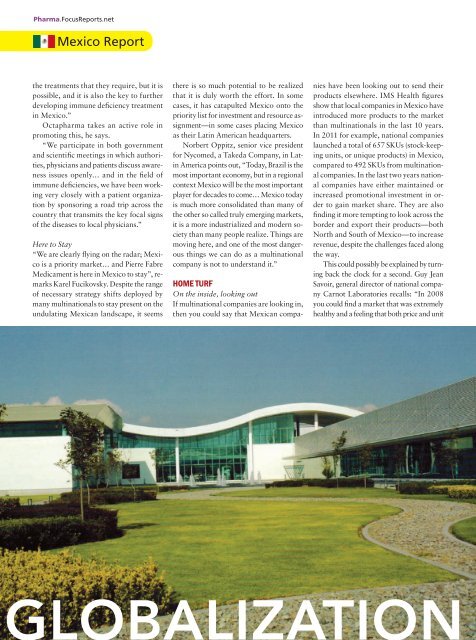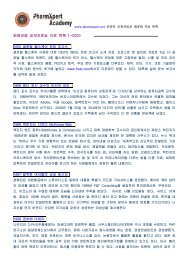Pharma report
Pharma report
Pharma report
You also want an ePaper? Increase the reach of your titles
YUMPU automatically turns print PDFs into web optimized ePapers that Google loves.
<strong>Pharma</strong>.FocusReports.net<br />
Mexico Report<br />
Mexico Report<br />
SPECIAL SPONSORED SECTION<br />
the treatments that they require, but it is<br />
possible, and it is also the key to further<br />
developing immune deficiency treatment<br />
in Mexico.”<br />
Octapharma takes an active role in<br />
promoting this, he says.<br />
“We participate in both government<br />
and scientific meetings in which authorities,<br />
physicians and patients discuss awareness<br />
issues openly… and in the field of<br />
immune deficiencies, we have been working<br />
very closely with a patient organization<br />
by sponsoring a road trip across the<br />
country that transmits the key focal signs<br />
of the diseases to local physicians.”<br />
Here to Stay<br />
“We are clearly flying on the radar; Mexico<br />
is a priority market… and Pierre Fabre<br />
Medicament is here in Mexico to stay”, remarks<br />
Karel Fucikovsky. Despite the range<br />
of necessary strategy shifts deployed by<br />
many multinationals to stay present on the<br />
undulating Mexican landscape, it seems<br />
there is so much potential to be realized<br />
that it is duly worth the effort. In some<br />
cases, it has catapulted Mexico onto the<br />
priority list for investment and resource assignment—in<br />
some cases placing Mexico<br />
as their Latin American headquarters.<br />
Norbert Oppitz, senior vice president<br />
for Nycomed, a Takeda Company, in Latin<br />
America points out, “Today, Brazil is the<br />
most important economy, but in a regional<br />
context Mexico will be the most important<br />
player for decades to come… Mexico today<br />
is much more consolidated than many of<br />
the other so called truly emerging markets,<br />
it is a more industrialized and modern society<br />
than many people realize. Things are<br />
moving here, and one of the most dangerous<br />
things we can do as a multinational<br />
company is not to understand it.”<br />
HOME TURF<br />
On the inside, looking out<br />
If multinational companies are looking in,<br />
then you could say that Mexican companies<br />
have been looking out to send their<br />
products elsewhere. IMS Health figures<br />
show that local companies in Mexico have<br />
introduced more products to the market<br />
than multinationals in the last 10 years.<br />
In 2011 for example, national companies<br />
launched a total of 657 SKUs (stock-keeping<br />
units, or unique products) in Mexico,<br />
compared to 492 SKUs from multinational<br />
companies. In the last two years national<br />
companies have either maintained or<br />
increased promotional investment in order<br />
to gain market share. They are also<br />
finding it more tempting to look across the<br />
border and export their products—both<br />
North and South of Mexico—to increase<br />
revenue, despite the challenges faced along<br />
the way.<br />
This could possibly be explained by turning<br />
back the clock for a second. Guy Jean<br />
Savoir, general director of national company<br />
Carnot Laboratories recalls: “In 2008<br />
you could find a market that was extremely<br />
healthy and a feeling that both price and unit<br />
GLOBALIZATION<br />
S13 FOCUS REPORTS AUGUST 2012<br />
18 August 2012<br />
FOCUS REPORTS
















